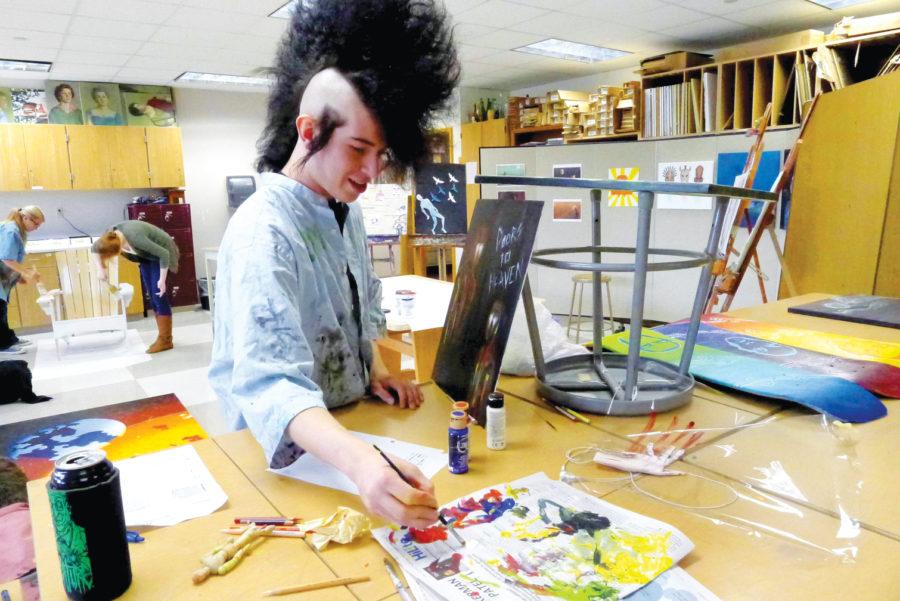Much like a classic Pixar movie, the artwork of senior Nathaniel “Nate” Harcourt always encompasses a deeper meaning than meets the eye.
“I focus my art on effecting change. I don’t focus solely on the technicality of my work,” Harcourt said.”I also try to define the concept and message that I want to broadcast.”

Within the walls of this school, art students are challenged to see beyond simple aesthetics. They’re ordered to dig deeper and convey a message that speaks to an audience. “They’re taught to create artwork that supports, echoes, and even summarizes powerful words in a visual form,” art teacher Michael Lee said of his teaching prerogative.
Walking down the streets of downtown Carmel, Harcourt took note of the ‘Carmel Statues’ expressing the varieties of humanity, the potential of people.
But Harcourt noticed their faults. Their uncompromising structures. Their efforts to make Carmel seem more perfect than it could be.
“They’re meant to embellish life, but they’re cold, lifeless structures,” Harcourt said.
So in the fall of 2010, Harcourt sculpted his own version of a man reading a newspaper, hoping to impact society with his art. Crafted out of soda cans for the body and a television for the head, the sculpture travels down the road less taken, one that criticizes rather than applauded.
“My sculpture is designed to illustrate this human lifelessness while the other statue is meant to hide it,” he said.
Influential art stands as only one category of art, but it can trigger a dramatic effect on the public. As Lee said, “My perception is that influential art is created with the purpose to sway a viewer’s opinion, much like a persuasive essay.”
Junior Francisca “Franci” Figueroa, first stepped into Carmel’s art department as a freshman. It was here that she learned the basics of sketching then eventually painting. It was here that she was challenged to uncover more than the aesthetics of a paintings by seeing the message behind the piece. And it was here that she branched out into independent realms, where she applied the guidelines to her own creations.
Says Figueroa, now enrolled in AP Studio Art, “The whole purpose of art in general is to convey your own feelings. It doesn’t need a definite purpose. It can be something that speaks to you and hopefully to others. It can make an audience think about a subject that it usually doesn’t think about.”
And in her AP Studio Art class, she paints what speaks to her. Designed to provide students with a portfolio for college, the independent class offers students the prospect of selecting a theme to explore the first year. As months pass, students explore compositions that mold to their theme.
“The whole purpose of the theme is to portray meaning through your artwork,” Figueroa said.
While classmates have pursued political or other more tangible themes, Figueroa said she has embraced a more intricate premise, one that encompasses the human conscience and the emotions attached.
“I haven’t found a title for the collection yet, I do a lot of work with portraiture and I try to capture different isolated emotions through people,” Figueroa said of her theme.
The lack of a title does not compromise the depth and potential of her theme, she says. Rather it provides her with a chance to not fall prey to defined boundaries. As Figueroa explained, “I do not want to be limited by a name.”
Also a student in Drawing 5-6, Figueroa recently completed a unit that focuses on drawing from a more political standpoint. For the assignment, she said she explored the depths of dictatorship, an idea that she said stemmed from an article she came across in the winter. Kim Jong Il and North Korea had served as the focus of the article and dictatorship brushed the surface of the interview.
“In the article, Kim Jong Il had asked the people of his country to rise up like a human shield to protect him,” Figueroa said. “I read that statement and almost immediately, I was against it. I was inspired to show that.”
Harcourt said that he centers his attention on the media and how society is unknowingly twisted by the news. His focus is visible in his portfolio, in which the range of sculptures to paintings explores how people are continually manipulated by the media.
To Harcourt, influential art is only effective if viewers explore what the work is for.
“Anyone can look a piece of art and comment on how it’s pretty,” Harcourt said. “But it takes a driven mind to see the meaning behind it.”




























![Keep the New Gloves: Fighter Safety Is Non-Negotiable [opinion]](https://hilite.org/wp-content/uploads/2024/12/ufcglovescolumncover-1200x471.png)















































![Review: “We Live in Time” leaves you wanting more [MUSE]](https://hilite.org/wp-content/uploads/2024/12/IMG_6358.jpg)
![Review: The premise of "Culinary Class Wars" is refreshingly unique and deserving of more attention [MUSE]](https://hilite.org/wp-content/uploads/2024/12/MUSE-class-wars-cover-2.png)
![Introducing: "The Muses Who Stole Christmas," a collection of reviews for you to follow through winter [MUSE]](https://hilite.org/wp-content/uploads/2024/12/winter-muse-4.gif)
![Review: "Meet Me Next Christmas" is a cheesy and predictable watch, but it was worth every minute [MUSE]](https://hilite.org/wp-content/uploads/2024/11/AAAAQVfRG2gwEuLhXTGm3856HuX2MTNs31Ok7fGgIVCoZbyeugVs1F4DZs-DgP0XadTDrnXHlbQo4DerjRXand9H1JKPM06cENmLl2RsINud2DMqIHzpXFS2n4zOkL3dr5m5i0nIVb3Cu3ataT_W2zGeDAJNd_E-1200x884.jpg)
![Review: "Gilmore Girls", the perfect fall show [MUSE]](https://hilite.org/wp-content/uploads/2024/11/gilmore-girls.png)
![Review in Print: Maripaz Villar brings a delightfully unique style to the world of WEBTOON [MUSE]](https://hilite.org/wp-content/uploads/2023/12/maripazcover-1200x960.jpg)
![Review: “The Sword of Kaigen” is a masterpiece [MUSE]](https://hilite.org/wp-content/uploads/2023/11/Screenshot-2023-11-26-201051.png)
![Review: Gateron Oil Kings, great linear switches, okay price [MUSE]](https://hilite.org/wp-content/uploads/2023/11/Screenshot-2023-11-26-200553.png)
![Review: “A Haunting in Venice” is a significant improvement from other Agatha Christie adaptations [MUSE]](https://hilite.org/wp-content/uploads/2023/11/e7ee2938a6d422669771bce6d8088521.jpg)
![Review: A Thanksgiving story from elementary school, still just as interesting [MUSE]](https://hilite.org/wp-content/uploads/2023/11/Screenshot-2023-11-26-195514-987x1200.png)
![Review: "When I Fly Towards You", cute, uplifting youth drama [MUSE]](https://hilite.org/wp-content/uploads/2023/09/When-I-Fly-Towards-You-Chinese-drama.png)
![Postcards from Muse: Hawaii Travel Diary [MUSE]](https://hilite.org/wp-content/uploads/2023/09/My-project-1-1200x1200.jpg)
![Review: "Ladybug & Cat Noir: The Movie," departure from original show [MUSE]](https://hilite.org/wp-content/uploads/2023/09/Ladybug__Cat_Noir_-_The_Movie_poster.jpg)
![Review in Print: "Hidden Love" is the cute, uplifting drama everyone needs [MUSE]](https://hilite.org/wp-content/uploads/2023/09/hiddenlovecover-e1693597208225-1030x1200.png)
![Review in Print: "Heartstopper" is the heartwarming queer romance we all need [MUSE]](https://hilite.org/wp-content/uploads/2023/08/museheartstoppercover-1200x654.png)




